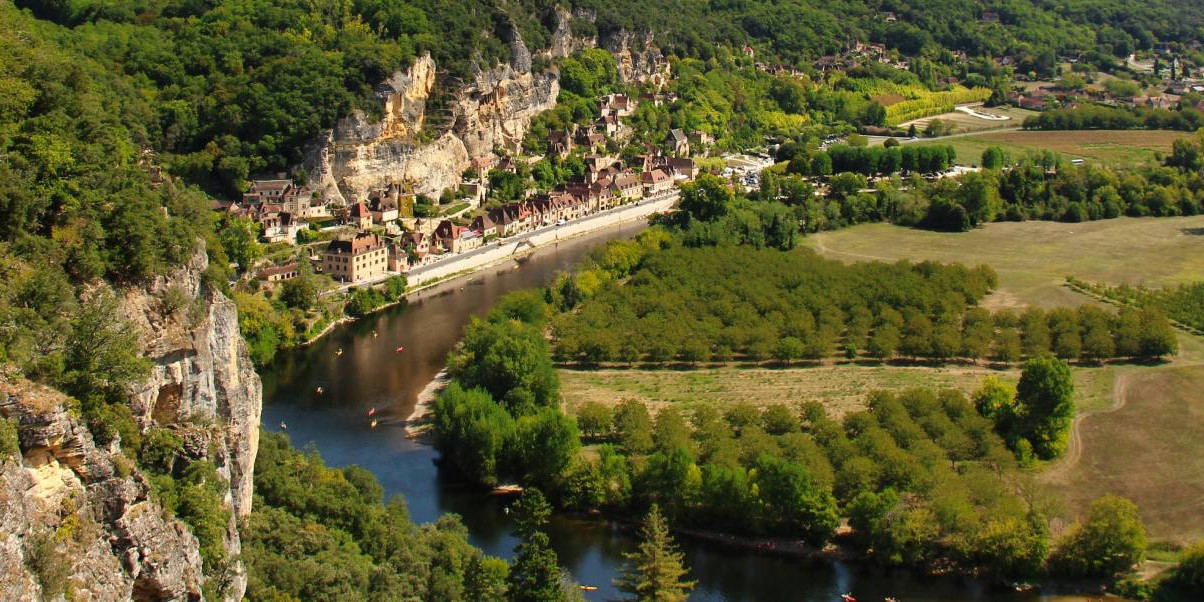Located in the heart of Corrèze, our Dordogne Valley campsite invites you to explore the treasures of the surrounding area. Discover the cultural and historical heritage, natural sites, and charming towns and villages of the Dordogne Valley.
Rent a Mobile Home in the Dordogne Valley
If you’re planning a stay in a Dordogne Valley campsite, you have several rental options:
- Mobile homes can accommodate between 2 and 8 people, perfect for couples, families, or groups.
- Rental prices vary depending on the amenities and capacity of the mobile home, as well as seasonal availability.
- For instance, the Coco Sweet starts at €259 per week in the low season and €792 in the high season. This rental includes two bedrooms: one with a double bed and another with two single beds, along with a fully equipped kitchenette.
- For more space, the Cottage Privilege with two bedrooms, a bathroom, and a toilet starts at €357 per week in the low season.
Alternatively, you can choose traditional camping pitches.
Choose a Stay in the Dordogne Valley
A stay in the Périgord offers a chance to uncover some of France’s hidden gems:
- Nature: With rivers, forests, and mountains, the Dordogne Valley is perfect for nature enthusiasts.
- Activities: Visit Saint-Robert, Turenne Castle, Rocamadour, and Sarlat-la-Canéda.
- Family: The activities, camping facilities, and serene environment make it perfect for family vacations.
- Tranquility: Far from urban noise, campsites in the Lot region allow for true relaxation.
- Affordable Vacations: Camping Le Gibanel offers budget-friendly rental options.
Tourist Activities in the Dordogne Valley
With an incredibly rich historical heritage and an exceptional natural setting, the Dordogne Valley is brimming with tourist attractions: from prehistoric sites, medieval villages, fortified castles, and natural wonders to gourmet gastronomy, your stay promises to be unforgettable. From the campsite in Corrèze, come and explore this magnificent region. For an unforgettable holiday in Corrèze, choose our campsite, Le Gibanel!
The Dordogne Valley is renowned for its incredible density of castles: don't miss the Merle Towers and the fortified castles of Castelnau-Bretenoux or Fénelon, the Renaissance charm of Montal, or the 17th- and 18th-century elegance of Hautefort and La Pannonie castles.
A land of art and history, the Dordogne Valley also boasts numerous exceptional sites, spanning from prehistoric heritage to the most significant landmarks of the Middle Ages. Paleontology and prehistory enthusiasts will enjoy the parietal paintings of the Merveilles Cave, the Neanderthal Museum in La-Chapelle-aux-Saints, and the Fieux Archeosite in Miers. The architectural heritage of the towns also reflects life in the valley during the Middle Ages and the Renaissance: among the must-sees is the enchanting religious city of Rocamadour.
The natural heritage is among the richest and most diverse in France. The extensive network of waterways, partly underground, has given rise to stunning concretions caves: during your stay, consider visiting the Lacave Caves, the Presque Caves, and the unmissable Padirac Chasm.
The Rivers in the Dordogne Valley
Below is a list of rivers in the Dordogne Valley:
- Dordogne
- Maronne
- Cère
- Ouysse
The Dordogne Valley is a fantastic playground for water sports and aquatic activities. The ten dams along its course have created large expanses of calm water ideal for swimming, fishing, barge trips, and family-friendly activities like paddleboarding, pedal boating, or canoeing. These dams are also points of interest to visit, where you can learn about hydroelectric mechanisms and enjoy breathtaking views. In other areas, the Dordogne’s waters turn lively, making it perfect for hydrospeed, whitewater kayaking, and adventure courses.
The Most Beautiful Villages in the Dordogne Valley
The Dordogne Valley is home to many charming villages. Among them, several are listed as "The Most Beautiful Villages in France," and they deserve special attention for their beauty and the richness of their heritage:
- Autoire, also known as the "Little Versailles."
- Carennac, where Renaissance houses line the river around the Château des Doyens.
- Collonges-La-Rouge, the "City of 25 Red Sandstone Towers."
- The medieval village of Curemonte, boasting three castles, three churches, and three fountains.
- Loubressac, a hilltop village offering a unique panoramic view of the valley.
Historical Heritage of the Dordogne Valley
Designated as a "Land of Art and History," the Dordogne Valley is renowned for its churches, manor houses, gardens, and castles. Among the highlights are the castles of Castelnaud and Beynac, sworn enemies during the Hundred Years' War. Other popular sites include the castles of Fénelon, Rocamadour, Hautefort, Pannomie, and Vassinhac.
It was in this magnificent residence that Joséphine found refuge at the beginning of the German Occupation. It was also here that the woman known as the "Black Venus" received a visit from an officer of the French military intelligence service, who proposed that she become an "honorable correspondent"—a term the American artist preferred to "spy." She would go on to carry out numerous intelligence missions with high-ranking political and military officials, including Mussolini.
The Dordogne Valley also charms visitors with the authenticity of its villages, particularly the five that belong to the "Most Beautiful Villages of France." Three are located in the north of Lot, in Occitanie: Autoire, Carennac, and Loubressac; the other two are in the south of Corrèze, in Nouvelle-Aquitaine: Collonges-la-Rouge and Curemonte.
The Dordogne Valley: A Prehistoric Site
The prehistoric sites, including caves and chasms, contribute to the richness of the Dordogne Valley's heritage. Some of these sites are internationally renowned, especially the Padirac Chasm and the Lascaux Cave. Other noteworthy sites include the Prehistoric Cave of Wonders, the Lacave Caves, and the Cougnac Caves. These locations contain numerous cave paintings, some dating back twenty to thirty thousand years, depicting animals, everyday objects, and even human figures. These works provide invaluable insights into the lifestyle and environment of the earliest human communities in Europe.
